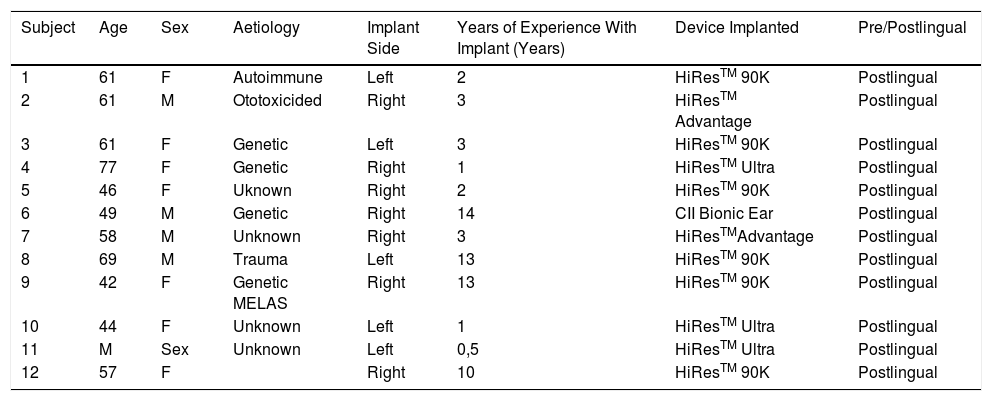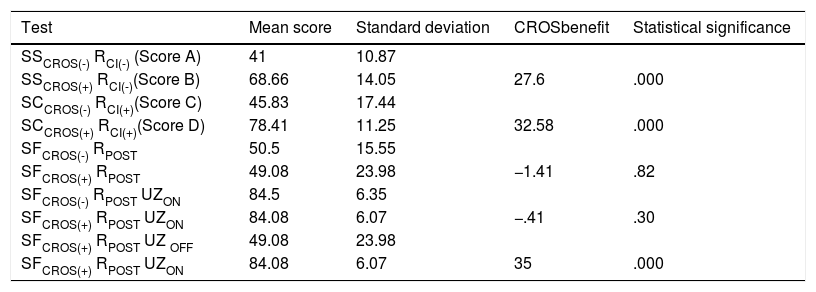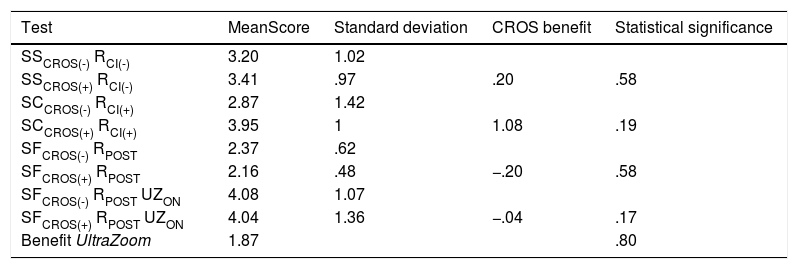Single cochlear implantation usually provides substantial speech intelligibility benefits but bilaterally deaf, unilaterally implanted subjects will continue to experience limitations due to the head shadow effect, like single-sided deaf individuals. In the treatment of individuals with single-sided deafness one option is contralateral routing of signal (CROS) devices, which constitute a non-surgical intervention of the second ear in unilaterally implanted individuals.
MethodTwelve experienced adult cochlear implant (CI) users with Naída Q70 processor and the CROS device used in combination participated in the study. For the study three conditions were provided: CI only, omnidirectional microphone mode (CROS deactivated); CI plus CROS activated, omnidirectional microphone mode and CI plus CROS activated, UltraZoom mode. Speech reception thresholds were determined in quiet and noise. Subjective feedback regarding the practical usability of the CROS device and the perceived benefit were collected.
ResultsThere was a 27.6% improvement in speech understanding in quiet and 32.5% improvement in noise when CROS device was activated. Using advanced directional microphones, a statistically significant benefit of 35% was obtained. The responses to the questionnaires revealed that the subjects perceived benefit in their everyday lives when using the CROS device with their CI.
ConclusionThe investigated CROS device used by unilateral CI recipients in cases where bilateral implantation is not an option provides both subjective and objective speech recognition benefit when the signal is directed to the CROS device. Unfavourable conditions where speech is presented from the CI side and noise from the CROS side or diffusely were not included in this evaluation since the CROS device adds additional noise and performance is expected to decrease as has previously been shown.
La implantación unilateral en la hipoacusia profunda bilateral deja al paciente en una situación de audición monoaural, con los consiguientes problemas audiológicos, en especial por la incapacidad de percepción de la palabra en ambientes con ruido de fondo, por el efecto sombra de la cabeza. Se puede mejorar su rendimiento auditivo aprovechando los sistemas inalámbricos de enrutamiento de la señal (CROS), para dotarlos de una entrada de sonido bilateral.
MétodoSe estudiaron doce usuarios unilaterales de implante coclear adultos, con experiencia con un procesador de sonido Naída CI Q70 que tiene capacidad de comunicación inalámbrica con el CROS. La comprensión del habla en cabina en silencio y en ruido se llevó a cabo utilizando como estímulos el test de oraciones grabadas en español en tres condiciones: habla dirigida hacia el oído no implantado con y sin CROS activado y habla de frente conUltraZoom. Tras un mes de uso del dispositivo CROS, se evaluó la satisfacción del usuario utilizando cuestionarios.
ResultadosEn silencio, la diferencia media entre el implante unilateral solo y el implante unilateral con el dispositivo CROS fue de 27,6%, mientras que en presencia de ruido fue de 32,5%. Si se comparan las puntuaciones entre presentar activada o no la opción UltraZoom al utilizar CROS, se demuestra un beneficio de un 35% de inteligibilidad. Todos los sujetos puntuaron su experiencia de uso como satisfactoria.
ConclusiónEl dispositivo CROS utilizado con CI unilateral, produce un beneficio objetivo y subjetivo en el reconocimiento de la palabra cuando la señal se dirige hacia el mismo. En este estudio no se reprodujo la condición de presentación de la señal verbal en el oído implantado con ruido en el adaptado con el CROS por haberse demostrado previamente que la discriminación verbal se deteriora de forma importante con respecto al implante unilateral sin CROS.















